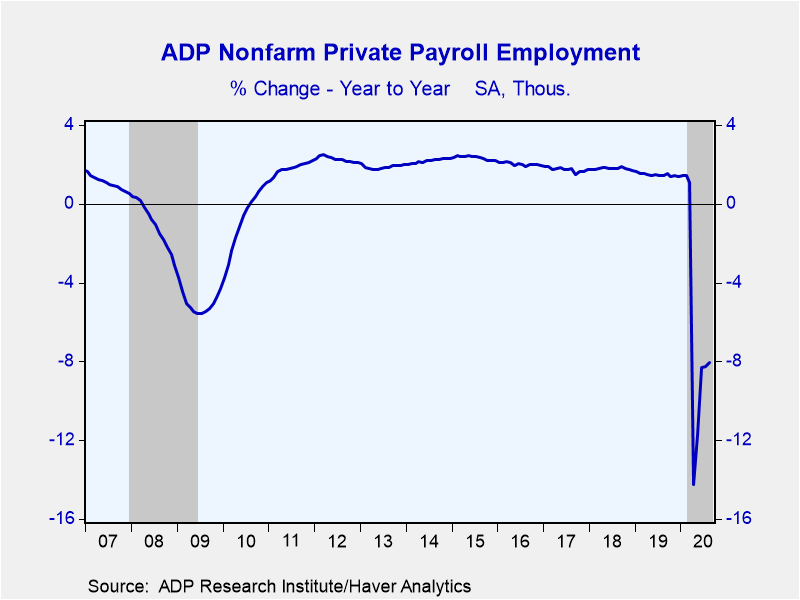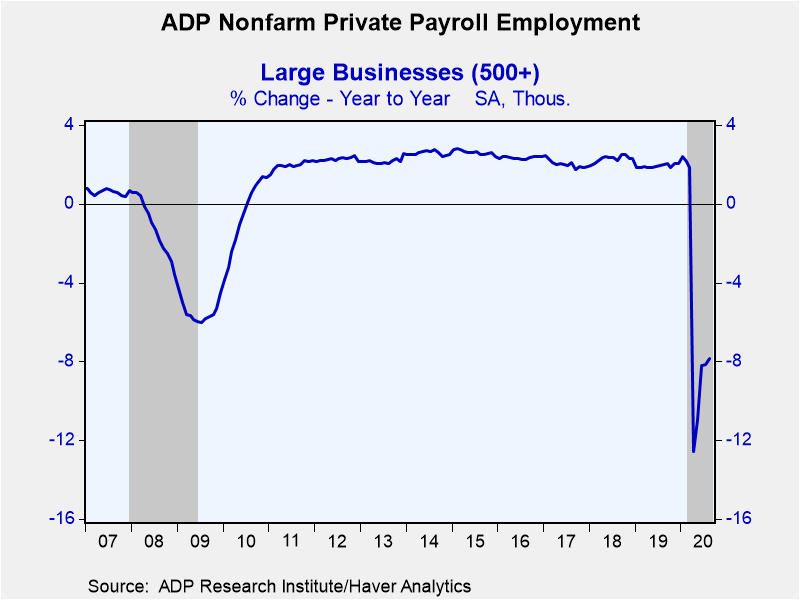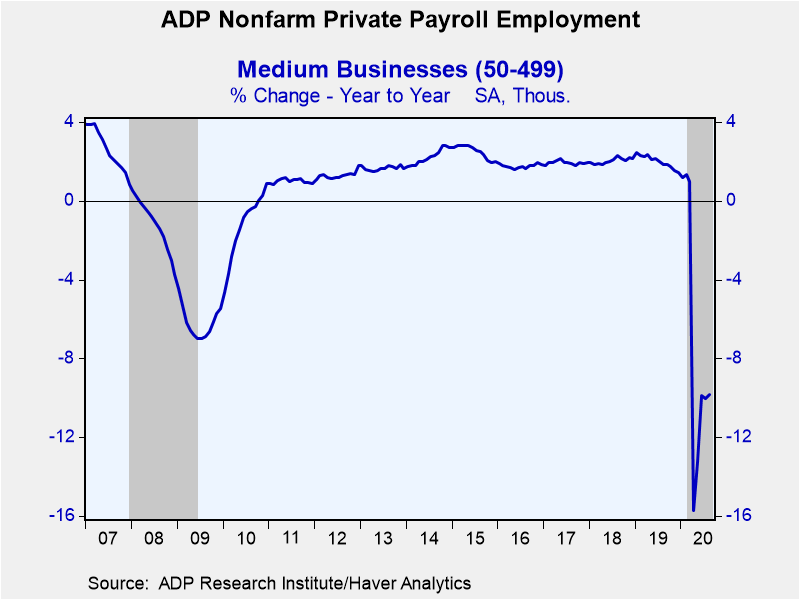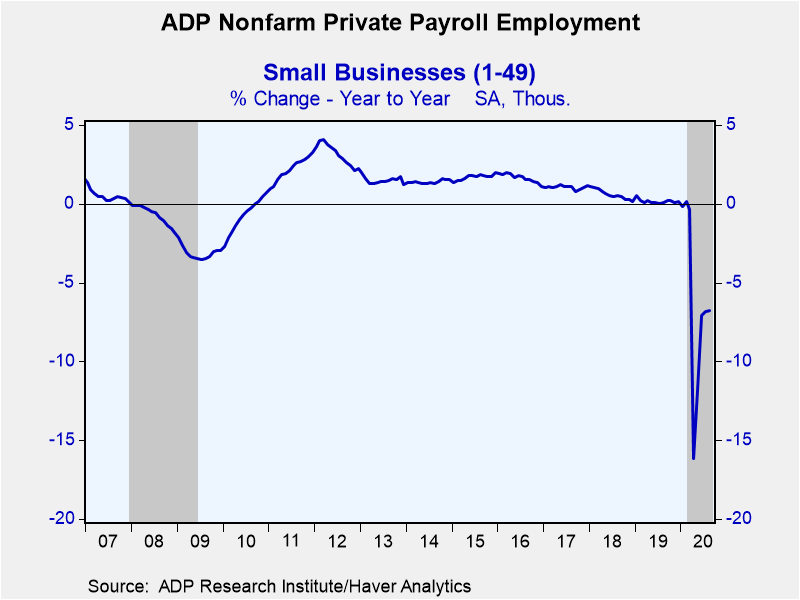 Global| Sep 02 2020
Global| Sep 02 2020U.S. ADP Nonfarm Private Payrolls Rise Moderately in August
by:Tom Moeller
|in:Economy in Brief
Summary
• Medium-sized payrolls recover, while large payroll growth improves further. • Employment gain falls short of expectations. Labor market improvement continued during August. The ADP National Employment Report indicated that nonfarm [...]
• Medium-sized payrolls recover, while large payroll growth improves further.
• Employment gain falls short of expectations.
Labor market improvement continued during August. The ADP National Employment Report indicated that nonfarm private payrolls gained 428,000 (-8.0% y/y) following a 212,000 July increase, revised from 167,000. That came after a 4.485 million June strengthening, revised from 4.314 million. The latest figure compared to a 875,000 increase expected in the Action Economics Forecast Survey. The ADP report is based on survey data through August 12.
Large payrolls increased 298,000 (-7.9% y/y) last month following a 157,000 July increase, revised from 129,000. Medium-sized payrolls improved 79,000 (-9.8% y/y) after falling 18,000 in July, revised from -25,000. Small-sized payrolls increased 52,000 in August (-6.8% y/y) after a 73,000 July increase, revised from 63,000.
Within industry sectors, employment amongst goods-producing firms rose 40,000 (-5.0% y/y) last month after a 2,000 July improvement, revised from 1,000. The size of construction sector payrolls rebounded 28,000 (-2.4% y/y) during August after a 15,000 July decline, revised from a 25,000 fall. Factory sector employment improved 9,000 (-6.0% y/y) last month which followed July's 18,000 increase, revised from 10,000. Employment in the natural resource & mining sector edged 2,000 higher (-13.7% y/y) and recouped a 1,000 worker decrease.
Employment in the private service sector rose 389,000 (-8.6% y/y) following a 211,000 July increase, revised from 166,000. A 129,000 rise (-24.5% y/y) in leisure & hospitality employment paced the increase as it followed a 41,000 improvement, revised from 38,000. The number of education & health services jobs rose 100,000 (-4.6% y/y) after a little-revised 48,000 increase. A 66,000 gain (-6.5% y/y) in the number of professional business services jobs came after an 82,000 July rise, revised from 58,000. Trade, transportation & utilities jobs increased 58,000 (-6.0% y/y) following a 50,000 increase, revised from 41,000. Jobs in financial services rose 11,000 (-1.5% y/y) following a 15,000 July decline, revised from -18,000. Information sector payrolls fell 1,000 (-10.9% y/y) and have been declining all year.
The Automatic Data Processing Research Institute survey covers 411,000 companies and includes about one-fifth of U.S. private payroll employment. The data are processed by Moody's Analytics Inc., then calibrated and aligned with the BLS establishment survey data. The ADP data cover private sector employment only.
The ADP National Employment Report data can be found in Haver's USECON database. Historical figures date back to 2001 for private employment and the industry breakdown, and 2005 for the business size breakout. The expectation figure is available in Haver's AS1REPNA database.
Employment Projections -- 2019-2029 from the U.S. Bureau of Labor Statistics can be found here.
| ADP/Moody's National Employment Report | Aug | Jul | Jun | Aug Y/Y | 2019 | 2018 | 2017 |
|---|---|---|---|---|---|---|---|
| Nonfarm Private Payroll Employment (m/m chg, 000s) | 428 | 212 | 4,485 | -8.0% | 1.5% | 1.8% | 1.7% |
| Small Payroll (1-49) | 52 | 73 | 1,536 | -6.8 | 0.2 | 0.6 | 1.1 |
| Medium Payroll (50-499) | 79 | -18 | 1,045 | -9.8 | 2.0 | 2.0 | 1.9 |
| Large Payroll (>500) | 298 | 157 | 1,904 | -7.9 | 1.9 | 2.3 | 2.0 |
| Goods-Producing | 40 | 2 | 591 | -5.0 | 1.6 | 2.9 | 1.8 |
| Construction | 28 | -15 | 289 | -2.4 | 2.7 | 4.1 | 3.7 |
| Manufacturing | 9 | 18 | 317 | -6.0 | 1.0 | 1.9 | 0.8 |
| Service-Producing | 389 | 3,895 | -8.6 | 211 | 1.5 | 1.6 | 1.7 |
Tom Moeller
AuthorMore in Author Profile »Prior to joining Haver Analytics in 2000, Mr. Moeller worked as the Economist at Chancellor Capital Management from 1985 to 1999. There, he developed comprehensive economic forecasts and interpreted economic data for equity and fixed income portfolio managers. Also at Chancellor, Mr. Moeller worked as an equity analyst and was responsible for researching and rating companies in the economically sensitive automobile and housing industries for investment in Chancellor’s equity portfolio. Prior to joining Chancellor, Mr. Moeller was an Economist at Citibank from 1979 to 1984. He also analyzed pricing behavior in the metals industry for the Council on Wage and Price Stability in Washington, D.C. In 1999, Mr. Moeller received the award for most accurate forecast from the Forecasters' Club of New York. From 1990 to 1992 he was President of the New York Association for Business Economists. Mr. Moeller earned an M.B.A. in Finance from Fordham University, where he graduated in 1987. He holds a Bachelor of Arts in Economics from George Washington University.










